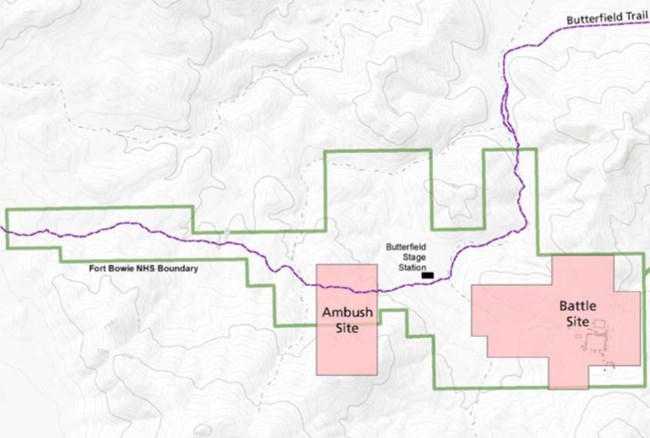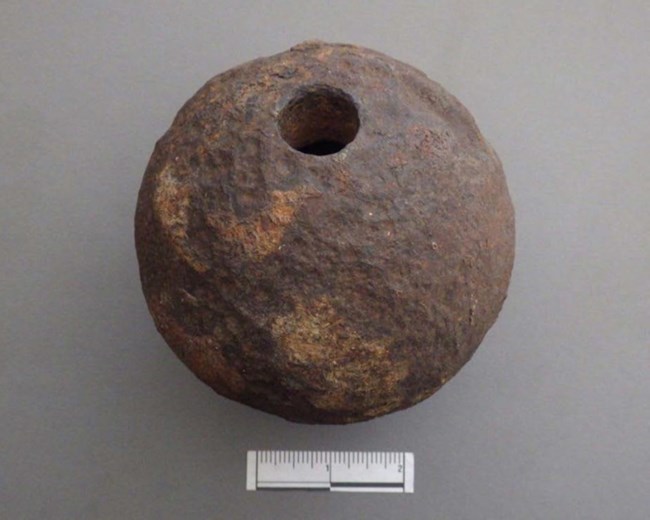
NPS In response to this threat, the California Volunteers were called up to protect Union interests in the west. A column of 5th California Volunteers, led by Captain Thomas L. Roberts, marched through present day southern Arizona. As the troops headed east, they faced threats from the inhospitable desert climate, as well as from the Native Americans that called this land home- the Chiricahua Apache. Captain Roberts left Tucson on July 10th, 1862. Five days later, he entered Apache Pass with part of his column. He had approximately 100 men (primarily infantry and six cavalrymen), supply wagons, livestock, and two mountain howitzers. Not suspecting any danger, the soldiers were anticipating a break on their long journey that day. They had marched 40 miles in the unforgiving sun that morning, and now they were eager to taste the water from Apache Spring and rest during the hottest part of the day. As they entered the pass, their pace quickened, the men, joking and singing, strung out along the road. The advance of the column reached the old stone stage station around 1 p.m. The cavalry had unsaddled their horses and most of the infantry had just broken ranks when they heard gunshots toward the west. The rear of the column had come under attack. The Apaches were led by Chokonen Leader Cochise, who had recruited Mangas Coloradas (Cochise’s father-in-law) and his band of Chihennes and Bedonkohes to participate in the fighting. Together, these bands probably numbered around 150 warriors. The Apaches had been watching the column as it approached and knew of the large herd of livestock and wagons of supplies that accompanied it. The prospects of capturing the supplies may have been a large motivation to engage the Army at Apache Pass. But undoubtedly, the memory of the Bascom Affair, that happened on this same ground just one year prior, was also a key motivating factor for Cochise. The loss of his family, who had been hung by the Army, had understandably flamed his animosity for the United States. The rear of the column, which consisted of supply wagons and the two mountain howitzers, had fallen behind the rest of the column. The Apache warriors ambushed the lightly guarded supplies as they traveled through the pass. When Captain Roberts heard the sound of fighting at the rear of the column, he quickly formed his infantry into skirmishers and advanced toward the firing. After what Roberts termed “a sharp little contest,” the army pushed the Apaches into the nearby hills. The Apache had likely divided their warriors into three groups: one preparing for the main fight at the spring, one watching the road for reinforcements or stragglers retreating, and one carrying out an ambush on the rear of the column. Through ambush and surprise, they had disrupted and inflicted casualties on the army, but in so doing, they eliminated the element of surprise. The soldiers now expected they would face more resistance as they approached the spring. The Apache had prepared well for this fight. They constructed stone breastworks near the tops of both hills overlooking the spring. They also used natural fortifications along the hillside above the approach and denser vegetation around the spring itself for cover. The Apache had the high ground, knowledge of the terrain, and comparable small arms fire power to the Army. They also outnumbered the soldiers. The Apaches were calculated in their approach towards warfare and they were not likely to engage an enemy if they were not confident in their ability to win a fight. The Apache had several advantages in this fight and that rightly bolstered their confidence at Apache Pass. After the ambush on their supplies, the Army had to quickly regroup their forces and come up with a battle tactic. The command desperately needed water, and with the spring still 600 yards up canyon, Captain Roberts knew they would have to fight for it. Roberts’s came up with a simple plan. He divided his infantry into two platoons. The first platoon would push forward to capture the spring while the battery supported it by shelling the high ground around the spring. The second infantry platoon would deploy as skirmishers and advance with the battery, and the six cavalrymen would support the howitzers. The first platoon of skirmishers advanced up the middle of the valley under continuous fire from the Apaches above. With the howitzers shelling the hillsides, the men came within 50 yards of the spring. Cheering as they saw water, they received heavy fire from Apaches hidden around the spring and in fortifications high on the hills above them. This first volley killed one private, who sustained a shot to the head. Seeing the 1st platoon staggered by the Apaches’ concentrated fire, Captain Roberts sounded the recall to regroup his forces before losing more men. Roberts knew that if he wanted to win this fight, he would have to seize the Apache positions on the high ground. Roberts brought up the howitzers to accomplish this objective, but the Army ran into several problems with the artillery. The battery crew had a difficult time targeting the entrenched Apache on the hills. Many shots sailed harmlessly over the hills and exploded out of a range. As the howitzers got closer to their targets, the battery crews came under heavy fire. And when the crews got closer to the Apache positions, they could no longer attain the elevation to hit their higher targets. To correct this issue, the crews began firing from slopes too steep for the gun’s recoil, which resulted in the howitzers flipping over backward. With the howitzers out of action, Roberts realized that only the infantry could now take the hills. Once again, he divided them into platoons. The first platoon of 20 men, commanded by Sergeant Fountain, would take the high hill on the left. The second would take the hill on the right, and the third would hold the middle and provide cover fire. Fountain deployed his men as skirmishers and advanced on the hill. He later described his method of attack: “They were ordered to advance alternately, that is 10 men would dash 10 or 12 yards to the front, lie down, and cover the other 10 as they made a dash, and so on. We pushed slowly up the hill in the face of a galling fire.” The Apaches put up a strong resistance sending a hail of bullets down the hill. But those bullets continued to overshoot Fountain’s men. When they reached the top, Fountain gave one final order to “fix bayonets.” Fountain and his men raced the last few yards to the Apache's fortified position. The Apaches fired a parting volley at the soldiers as they retreated down the steep hillside. Company E now occupied the fortification, a semi-circular stone breastwork 34 feet in diameter and about two feet high. With it came control of the spring below. When Fountain and his men carried the hill, they heard cheers from men below as they rushed toward the spring to fill anything that would hold water. The Apaches still on the right hill fired on the advancing men. Fountain’s men, having high-ground advantage, fired down on them from the left hill, forcing the Apache to retreat. The fighting had ceased for the moment. It was after 4 p.m. The first day of the battle was a long one. Both sides endured and inflicted casualties. The next day would bring another, much shorter, contest that resulted again in an Army victory. Though the warriors were defeated at the Battle of Apache Pass, the Apache were not defeated in their resolve to fight for their homeland. Against a strong Army, that significantly outnumbered them, the Chiricahua Apache continued to fight and evade forces has they fought to protect their families and way of life. The Battle of Apache Pass was just the beginning, both sides would see years of conflict unfold over the next two decades. 
NPS Archeological Findings of the Battle of Apache Pass- An NPS Resource Study |
Last updated: May 15, 2020
